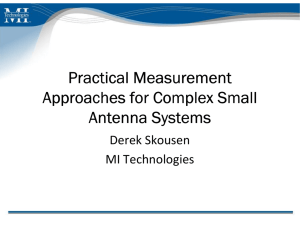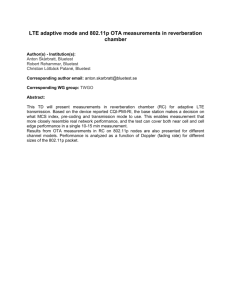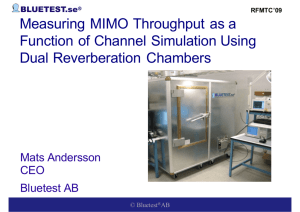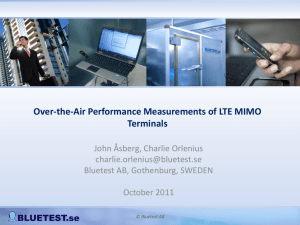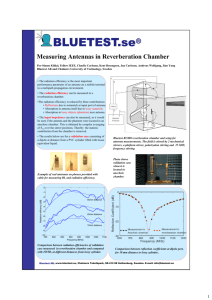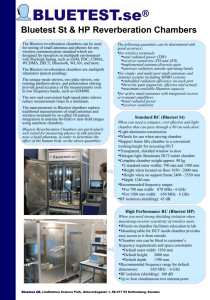Microsoft Word Viewer
advertisement
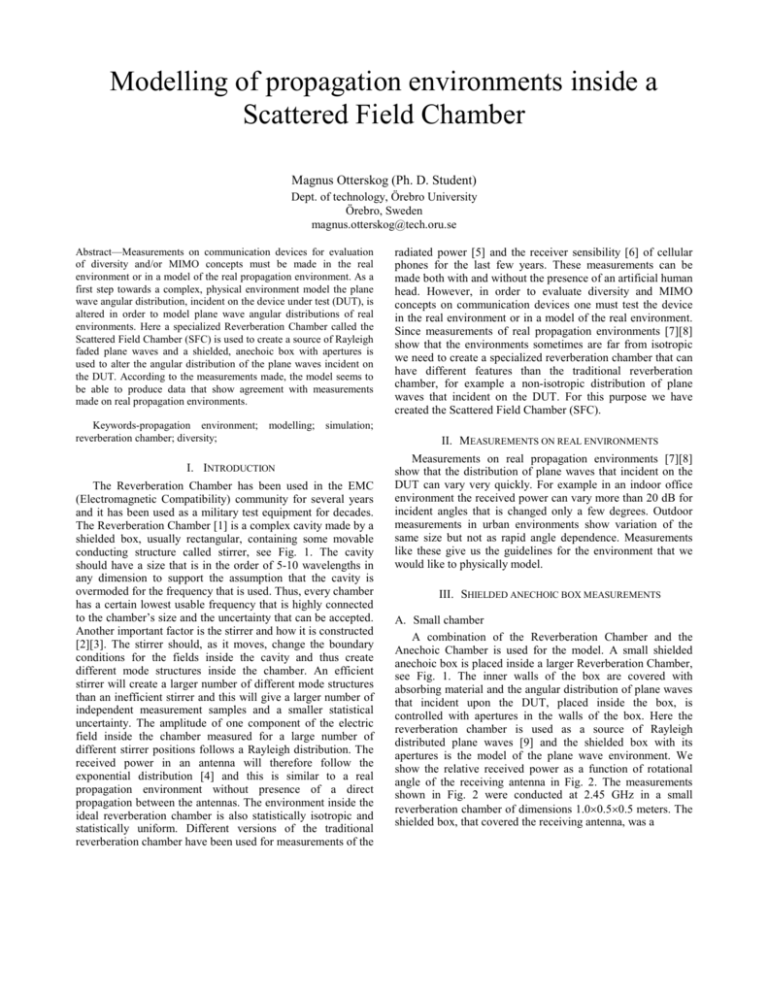
Modelling of propagation environments inside a Scattered Field Chamber Magnus Otterskog (Ph. D. Student) Dept. of technology, Örebro University Örebro, Sweden magnus.otterskog@tech.oru.se Abstract—Measurements on communication devices for evaluation of diversity and/or MIMO concepts must be made in the real environment or in a model of the real propagation environment. As a first step towards a complex, physical environment model the plane wave angular distribution, incident on the device under test (DUT), is altered in order to model plane wave angular distributions of real environments. Here a specialized Reverberation Chamber called the Scattered Field Chamber (SFC) is used to create a source of Rayleigh faded plane waves and a shielded, anechoic box with apertures is used to alter the angular distribution of the plane waves incident on the DUT. According to the measurements made, the model seems to be able to produce data that show agreement with measurements made on real propagation environments. Keywords-propagation environment; reverberation chamber; diversity; radiated power [5] and the receiver sensibility [6] of cellular phones for the last few years. These measurements can be made both with and without the presence of an artificial human head. However, in order to evaluate diversity and MIMO concepts on communication devices one must test the device in the real environment or in a model of the real environment. Since measurements of real propagation environments [7][8] show that the environments sometimes are far from isotropic we need to create a specialized reverberation chamber that can have different features than the traditional reverberation chamber, for example a non-isotropic distribution of plane waves that incident on the DUT. For this purpose we have created the Scattered Field Chamber (SFC). modelling; simulation; I. INTRODUCTION The Reverberation Chamber has been used in the EMC (Electromagnetic Compatibility) community for several years and it has been used as a military test equipment for decades. The Reverberation Chamber [1] is a complex cavity made by a shielded box, usually rectangular, containing some movable conducting structure called stirrer, see Fig. 1. The cavity should have a size that is in the order of 5-10 wavelengths in any dimension to support the assumption that the cavity is overmoded for the frequency that is used. Thus, every chamber has a certain lowest usable frequency that is highly connected to the chamber’s size and the uncertainty that can be accepted. Another important factor is the stirrer and how it is constructed [2][3]. The stirrer should, as it moves, change the boundary conditions for the fields inside the cavity and thus create different mode structures inside the chamber. An efficient stirrer will create a larger number of different mode structures than an inefficient stirrer and this will give a larger number of independent measurement samples and a smaller statistical uncertainty. The amplitude of one component of the electric field inside the chamber measured for a large number of different stirrer positions follows a Rayleigh distribution. The received power in an antenna will therefore follow the exponential distribution [4] and this is similar to a real propagation environment without presence of a direct propagation between the antennas. The environment inside the ideal reverberation chamber is also statistically isotropic and statistically uniform. Different versions of the traditional reverberation chamber have been used for measurements of the II. MEASUREMENTS ON REAL ENVIRONMENTS Measurements on real propagation environments [7][8] show that the distribution of plane waves that incident on the DUT can vary very quickly. For example in an indoor office environment the received power can vary more than 20 dB for incident angles that is changed only a few degrees. Outdoor measurements in urban environments show variation of the same size but not as rapid angle dependence. Measurements like these give us the guidelines for the environment that we would like to physically model. III. SHIELDED ANECHOIC BOX MEASUREMENTS A. Small chamber A combination of the Reverberation Chamber and the Anechoic Chamber is used for the model. A small shielded anechoic box is placed inside a larger Reverberation Chamber, see Fig. 1. The inner walls of the box are covered with absorbing material and the angular distribution of plane waves that incident upon the DUT, placed inside the box, is controlled with apertures in the walls of the box. Here the reverberation chamber is used as a source of Rayleigh distributed plane waves [9] and the shielded box with its apertures is the model of the plane wave environment. We show the relative received power as a function of rotational angle of the receiving antenna in Fig. 2. The measurements shown in Fig. 2 were conducted at 2.45 GHz in a small reverberation chamber of dimensions 1.0×0.5×0.5 meters. The shielded box, that covered the receiving antenna, was a Figure 1. A small SFC with a shielded anechoic box with apertures. Figure 2. The relative received power as a function of rotational angle of the receiving antenna placed inside the shielded box. Figure 3. The large shielded anechoic box with broadband horn antenna. distance to the aperture. The aperture was a circular aperture of 60 mm diameter and this is shown in Fig. 3. The broadband horn antenna was rotated with 22.5 degrees steps between 0 and 180 degrees giving 9 different directions. The standard gain horn with 22.5 degrees steps between 0 and 90 degrees. The aperture is placed in the 0 degree direction and at a distance of 53 cm from the aperture of the antennas. The relative received power was measured for 51 frequencies between 1.7 and 2.6 GHz. The result of a measurement at a single frequency for the first horn antenna, the broadband horn antenna with an approximate 3 dB beamwidth of 60 degrees for the used frequency, is presented in Fig. 4. The same thing for the other antenna, the standard gain horn antenna with an approximate 3 dB beamwidth of 30 degrees, is presented in Fig. 5. As we can see the reduction rate of plane waves seems to be faster for the standard gain antenna and thus the effect of the directivity of the receiving antenna is significant. Since antennas of finite directivity are used in the measurements the true reduction rates of plane waves from different directions are underestimated. cardboard box covered with aluminium foil and quadratic apertures of size 8 cm in the directions 0° and 180°. The interior of the box was covered with absorbers of type ECCOSORB LS16-22. The receiving antenna was rotated in 45 degrees steps between 0°and 180°. The receiveing antenna was a WLAN antenna with an approximate directivity of 8 dBi. This directivity will give a large 3 dB beamwidth and the antenna will receive a lot of energy directly from the aperture even though it is pointed away from the aperture. This will affect the measurements and the directional properties of the aperture will be underestimated. B. Large chamber In order to examine the effect of the finite directivity of the used receiving antenna we have also performed measurements as the ones above but this time in a large reverberation chamber (37 m3) with a large shielded anechoic box (1 m3) inside. This time two types of horn antennas with different directivity were placed inside the anechoic box with a constant Figure 4. The relative received power as a function of rotational angle of the receiving broadband horn antenna. Figure 5. The relative received power as a function of rotational angle of the receiving standard gain horn antenna (only 0 to 90 degrees). IV. FIELD STATISTICS The statistical distribution of the plane wave amplitudes that is received by the antenna is shown in Fig. 6. The cumulative distribution function (CDF) of the measured data are plotted together with a best fit CDF of a Rayleigh distributed variable. The measurement data are taken for the broadband horn antenna when it is pointed 22.5 degrees away from the circular aperture and the frequency is 2.6 GHz. Fig. 7 shows the same distributions but this time with logarithmic scales in order to enlargen the area for small signal levels. Figure 7. The CDF of measurements compared with best fit theoretical Rayleigh distributed variable, logarithmic scale. important factors of how large variation and how fast variation with angular shift that you can obtain in the measurements. The use of absorbers with finite attenuation and receiving antennas with finite directivity will underestimate both the possible maximum reduction of plane waves and also the maximum rate of reduction with angular shift of the receiving antenna. VI. FUTURE WORK Future work includes numerical simulation of the plane wave distribution inside a shielded, anechoic box with apertures as described above. Modelling of the statistics of the incoming plane waves, Rayleigh, Rice or Gauss distributed, has already been shown [10] but will need some further investigations. Methods to control the polarization of the incoming waves and the time spread must also be invented in order to model different real environments. In the end, real field tests on communication devices in different environments will be compared with tests in the SFC and the correlation will be examined. ACKNOWLEDGMENT I would like to thank Olof Lundén at the Swedish Defence Research Agency for valuable support when performing the measurements. REFERENCES Figure 6. The CDF of measurements compared with best fit theoretical Rayleigh distributed variable, linear scale. V. CONCLUSIONS The distribution of plane waves that incident upon the DUT can be controlled inside a SFC. The amount of reduction is high when a shielded, anechoic box with apertures is used to control the distribution. Reduction rates of about 20 dB can be obtained. The absorber quality and antenna directivity is [1] Bäckström, Lundén, Kildal, “Reverberation Chambers for EMC Susceptibility and Emission Analyses”, URSI the Review of Radio Science 1999-2002, 2002. [2] Wu, Chang, “The effect of an Electrically Large Stirrer in a ModeStirred Chamber” IEEE Transactions on electromagnetic compatibility, vol. 31, No. 2, May 1989. [3] Lundén, Bäckström, “Stirrer Efficiency in FOA Reverberation Chambers. Evaluation of Correlation Coefficients and Chi-Squared Tests” Proceedings of the 2000 IEEE International Symposium on Electromagnetic Compatibility, Washington DC USA, 2000. [4] Hill, “Electromagnetic Theory of Reverberation Chambers”, NIST Technical Note 1506, National Institute of Standards and Technology, December 1998. [5] Kildal, Carlsson, “TCP of 20 mobile phones measured in a reverberation chamber”, Bluetest report 2 (available from address: Bluetest AB, Chalmers teknikpark, 412 88 Gothenburg, Sweden or from e-mail: simon@kildal.se), Nov 2001. [6] Orlenius, Serafimov, Kildal, “Procedure for measuring radiation efficiency in downlink band for active mobile phones in a reverberation chamber”, IEEE Antennas and Propagation Society International Symposium 2003, Volume: 4, June 22-27, 2003, Pages 731-734. [7] Kalliola, “Experimental analysis of multidimensional radio channels”, Thesis for the degree of Doctor of science in Technology, Helsinki University of Technology, 2002. [8] Medbo, Berg, “Spatio-Temporal Channel Characteristics at 5 GHz in a Typical Office Environment”, IEEE VTC Fall 2001, 2001. [9] ] Svensén, “Reverberation Chamber as a radiation source”, The 2003 Reverberation Chamber, Anechoic Chamber and OATS Users Meeting, Austin TX USA, 2003. [10] Madsén, Hallbjörner, “Reverberation Chambers for Mobile Phone Antenna Tests”, The 2001 Reverberation Chamber, Anechoic Chamber and OATS Users Meeting, Bellevue WA USA, 2001.
